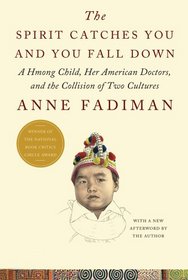Lisa G. (Lisa) reviewed The Spirit Catches You and You Fall Down: A Hmong Child, Her American Doctors, and the Collision of Two Cultures on + 51 more book reviews
Helpful Score: 7
This book changed the way I looked at immigration, culture, the right to choose medically. Very thought provoking book. Extremely well written.
Lynn R. (needa30hourday) reviewed The Spirit Catches You and You Fall Down: A Hmong Child, Her American Doctors, and the Collision of Two Cultures on + 26 more book reviews
Helpful Score: 6
I absolutely loved this book! It is written with such insight into the culture of the Hmong. It was an eye opener of the best kind - taking the reader into the midst of a medical case involving a very ill Hmong child in a small county hospital in California - language and cultural barriers that the author works to eliminate. Racial tensions, discrimination, miscommunication - the author worked through it and detailed the journey into a very readable, intelligent, thought-provoking piece of work.
Angela L. (Angela10angel) reviewed The Spirit Catches You and You Fall Down: A Hmong Child, Her American Doctors, and the Collision of Two Cultures on + 28 more book reviews
Helpful Score: 5
Awesome read! I loved it!! This was actually a text book for a medical anthro class, but I read it in two days (way ahead of the rest of the class). Great book.
Peg D. reviewed The Spirit Catches You and You Fall Down: A Hmong Child, Her American Doctors, and the Collision of Two Cultures on + 2 more book reviews
Helpful Score: 4
A Hmong child, her American doctors, and the collision of two cultures. Probably one of the best books I have ever read, a non-fiction that reads like a novel. This child is born with epilepsy, and the parents believe her condition is caused by spirits called "dabs", and don't administer her medications properly, if at all. Anne Fadiman is a wonderful writer, and you will be caught up in the drama as well as further understanding the Hmong people and their history. I can't recommend this highly enough.
Kathy S. (kswift) reviewed The Spirit Catches You and You Fall Down: A Hmong Child, Her American Doctors, and the Collision of Two Cultures on + 57 more book reviews
Helpful Score: 3
This book details the clash of two culturs: an immigrant Hmong family and the American medical system as each strives to keep the young daughter who has epilepsy healthy. Very though provoking--it provided the perspective of our medical care through the eyes of another culture. (good information for all health care professionals.) I also learned alot about the Hmong culture, how they were affected by the Vietnam war and how many immigrated to the US. This is not a light reading book; I also had a light-reading book to read so I could alternate between them as my mood dictated. Story plot detailed in other reviews.





![header=[] body=[Get a free book credit right now by joining the club and listing 5 books you have and are willing to share with other members!] Help icon](/images/question.gif?v=49a7bc70)
